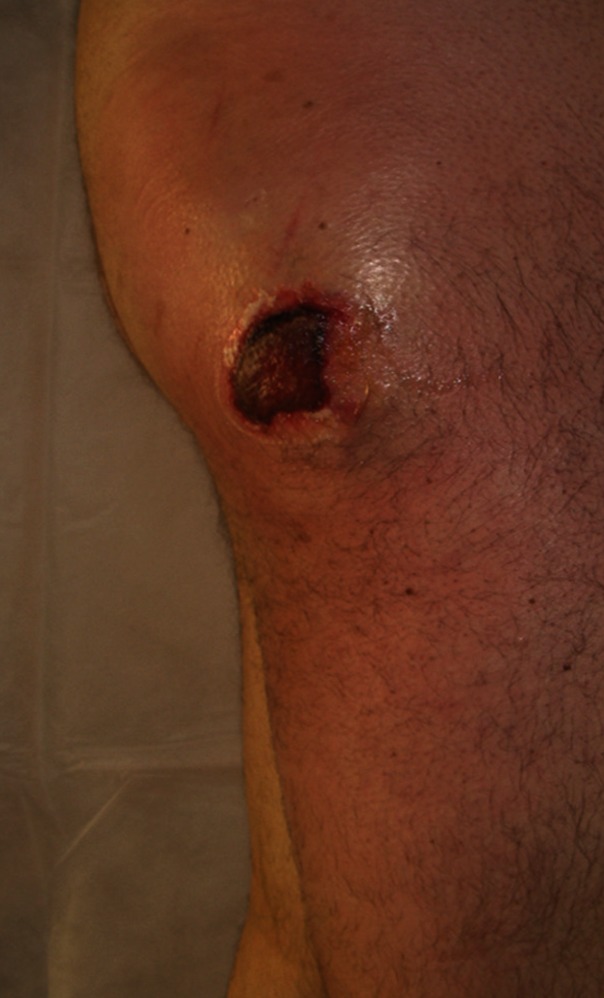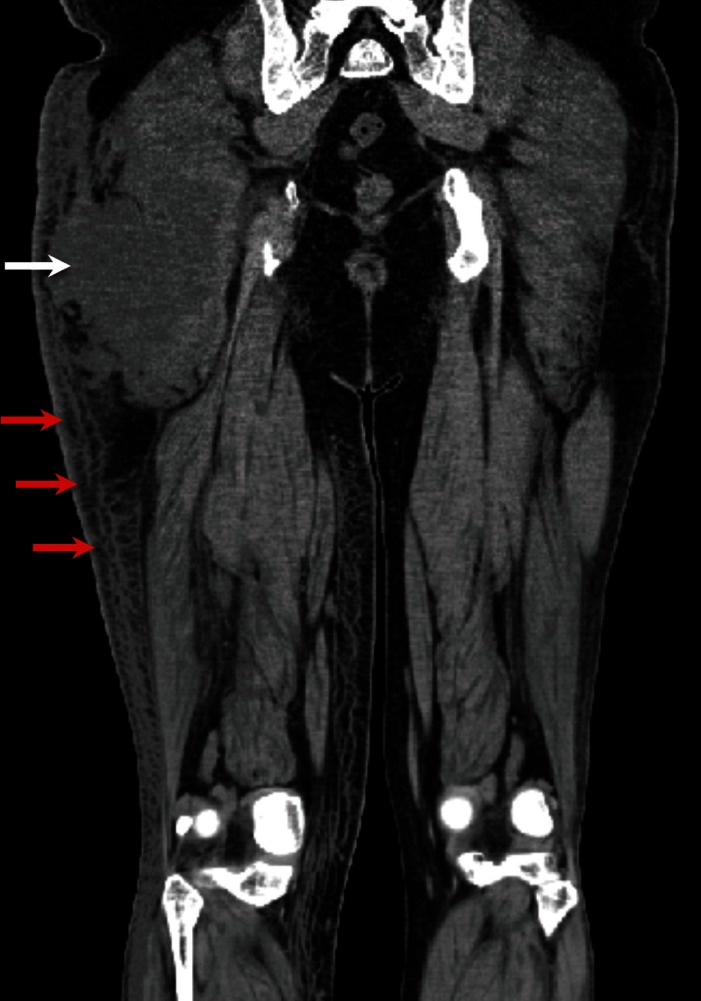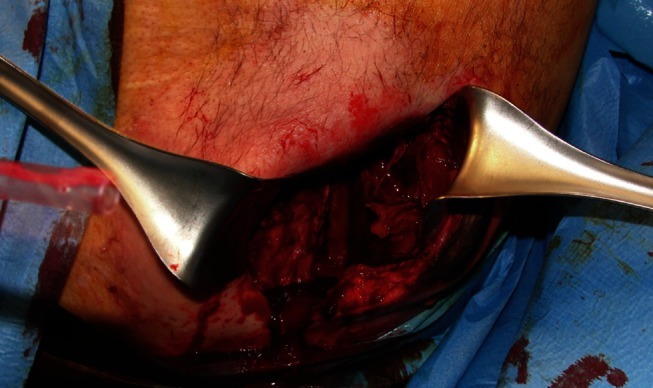Nicolau's Syndrome Complicated by Atypical Necrotizing Fasciitis
Article information
We read with interest the article by Kim and colleagues [1] entitled "Nicolau's syndrome after intramuscular injection: 3 cases." Recently, we published a case report in The Journal of Dermatology about embolia cutis medicamentosa [2]. Herewith, we highlight the lethal potential and the possible serious complications of this syndrome by reporting a case of complicated life-threatening Nicolau's syndrome. A 44-year-old white male patient was referred to our department with severe thigh pain and a painful cutaneous necrotic spot in the lower outer quadrant of the right buttock (Fig. 1). The patient reported that after an intra-muscular injection of diclofenac 10 days earlier, the gluteal region showed swelling followed by edema, discoloration, and erythema that evolved to a necrotic spot. The patient was drug-addicted and presented several comorbidities: viral (hepatitis B virus and hepatitis C virus) hepatic cirrhosis (Child-Pugh class A5), severe obesity (body mass index, 44.4) and uncompensated type II diabetes complicated by recurrent cutaneous pustulosis (Staphylococcus aureus and Streptococcus mitis). A physical examination revealed a 6×5 cm necrotic spot in the lower outer quadrant of the right buttock with edema and erythema of the posterior thigh. The patient was apyretic at the time of hospital admission; no increase in body temperature was observed during the hospital stay or the 3-month postoperative follow-up. A computerized tomography scan showed a gluteal 13×7 cm abscess involving the gluteus maximus muscle and the subcutaneous tissue, millimetric cutaneous gas bubbles in the right buttock and fat stranding with thickening of the skin, subcutaneous tissue, and fascia in the posterolateral thigh (Fig. 2). The diagnosis of Nicolau's syndrome complicated by abscess and necrotizing fasciitis of the posterior thigh was made. The patient underwent drainage of the abscessed cavity, followed by surgical debridement of the necrotic tissue (Fig. 3). Microbiological investigation demonstrated a penicillin-and cephalosporin-resistant Staphylococcus aureus infection that was treated with teicoplanin. Nicolau's syndrome is a rare complication that may occur after intra-muscular injection of several drugs [2,3]. Patients often describe immediate pain that increases after the injection, followed by edema, discoloration, net-like erythema, a livedoid violaceous patch, and ulceration. Tissue necrosis may only involve the cutis and subcutis or even extend deep to the fascia and muscle. The treatment depends both on the timing of the diagnosis and the symptoms. In most cases, embolia cutis medicamentosa presents with only local necrosis; therefore, subcutaneous heparin injections plus intravenous corticoid administration within the first 36 hours may be sufficient to achieve healing, while surgical debridement is required in the case of late diagnosis. On the other hand, it may become complicated with infection and life-threatening conditions such as necrotizing fasciitis, myositis or sepsis, limb gangrene, paraplegia, or death [4]. Moreover, the area of poorly vascularized tissue often extends beyond the visible area of necrosis and, as a consequence, the undiagnosed and consequently untreated damaged tissue may be prone to bacterial colonization and very poor wound healing. In our case, the livedoid dermatitis of the right buttock was complicated with an extensive abscess and necrotizing fasciitis. The latter is an uncommon and rapidly spreading infection involving the superficial fascial plane and subcutaneous tissue with a high risk of systemic toxicity and complications like adult-respiratory distress syndrome, acute renal failure, cardiac failure, or even multi-organ failure. Risks factors include immunosuppression, diabetes, age older than 50 years, malnutrition, and peripheral vascular disease [5]. The mortality rate is around 34%, and it is classified into two types: type 1, which accounts for about two thirds of the cases, is polymicrobial and mainly occurs in association with significant co-morbidities, while type 2 is caused by group A Streptococcus mainly in patients with a history of trauma, intravenous drug abuse, or surgery [4]. These classification criteria were not applicable to our patient's condition, as microbiological investigation proved a Staphylococcus aureus monomicrobial infection. Furthermore, our patient was apyretic, while fever and chills are among the most common beginning symptoms of necrotizing fasciitis. In conclusion, embolia cutis medicamentosa is a very rare pathology whose risk factors remain to be completely elucidated. In most of cases, it presents with only local symptoms but, especially in the presence of comorbidities such as an immunocompromised state, complications are likely to arise and lead to the patient's death. Our case remarkably highlights the potentially serious consequences of Nicolau's syndrome. Plastic and dermatologic surgeons must be well aware that prevention, timing of diagnosis, and treatment are crucial for the patient's prognosis.

Preoperative view. Necrotic spot surrounding the area of intramuscular injection, with swelling and erythema of the gluteal region and postero-lateral thigh.
Notes
No potential conflict of interest relevant to this article was reported.

